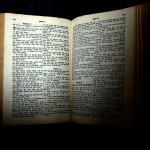 An interesting and newly discovered primary source on Mormonism has fallen into the hands of the bloggers here at FPR,and I was duly selected to analyze it for publication. A rare document like this might rightfully belong in the Journal of Mormon History, or perhaps BYU Studies, which occasionally publishes interesting newly discovered documents. Nevertheless, the rise of popularity regarding the Bloggernacle and the intense competition amongst various blogs to provide the best and most interesting coverage has led me to squander the opportunity for print publication in order to bring it to you, the reader’s, attention as quickly as possible. First, a little background.
An interesting and newly discovered primary source on Mormonism has fallen into the hands of the bloggers here at FPR,and I was duly selected to analyze it for publication. A rare document like this might rightfully belong in the Journal of Mormon History, or perhaps BYU Studies, which occasionally publishes interesting newly discovered documents. Nevertheless, the rise of popularity regarding the Bloggernacle and the intense competition amongst various blogs to provide the best and most interesting coverage has led me to squander the opportunity for print publication in order to bring it to you, the reader’s, attention as quickly as possible. First, a little background.
In 1844 prolific pamphleteer Parley P. Pratt published the lengthily-titled An appeal to the inhabitants of the state of New York, letter to Queen Victoria, the fountain of knowledge; immortality of the body, and intelligence and affection at Nauvoo. It included an essay called “Immortality and Eternal Life of the Material Body” in which Pratt enthusiastically preached about the location and nature of the millennial reign of Christ, during which
“men that are prepared will actually possess a material inheritance on the earth. They will possess houses, and cities, and villages, and gold and silver, and precious stones, and food, and raiment, and they will eat, drink, converse, think, walk, taste, smell and enjoy. They will also sing and preach, and teach, and learn, and investigate; and play on musical instruments, and enjoy all the pure delights of affection, love, and domestic felicity. While each, like the risen Jesus can take his friend by the hand and say: “Handle me and see; for a spirit hath not flesh and bones, as ye see me have.”
Pratt’s view is quite materially bound.[1] One might be tempted to view early Mormon thought as rather monolithic, but the available historical records introduce more nuance that one might expect. Pratt’s expectations of a material millennial kingdom were grounded on a literal reading of the Bible. But it was not an undisputed reading even amongst Mormons, as seen in an 1837 exchange between non-Mormon S. A. Davis and Warren Cowdery, editor of the Mormon newspaper Messenger & Advocate at Kirtland, Ohio. The exchange demonstrates early hints at Pratt’s materialism, non-Mormon reaction to such views, and contested perspectives of another Mormon at the time in the Church’s own organ.
S.A. Davis, editor of a Universalist newspaper, visited Kirtland in 1837 to see for himself this unusual growing sect sometimes called “Mormonite.” He reported that he had been “hospitably entertained and kindly treated by Elder [Parley] Pratt and others, who spent most of their time while we were there, in showing us the ‘buildings of the temple,’ and giving us instruction of their new religion.” Davis was most impressed with the “kindness” and “liberality of sentiment and Christian charity” exhibited by the saints, but also found them in some respects quite “superstitious.” What struck him most was their belief “that the glorious millenium [sic] is at hand.” On this point “they have too much worldly wisdom connected with their religion—too great a desire for the perishable riches of this world—holding out the idea that the kingdom of Christ is to be composed of ‘real estate, herds, flocks, silver, gold,’ &c. as well as of human things.”[2]
Undoubtedly, Pratt’s instruction to Davis emphasized the materiality of the kingdom. Nevertheless, even some Mormons were uncomfortable with Pratt’s material descriptions. W.A. Cowdery reprinted Davis’s salutary article in the Messenger & Advocate, commending Davis’s kindness but taking issue with his objection to the temporal expectations of the saints:
“There may be,” wrote Cowdery, “and indeed we fully believe there is, an undue attachment in some of the saints to amass wealth and heap up perishable treasure.” However, “We believe the gentleman must be mistaken if he has imbibed an idea that we consider the kingdom of heaven will be composed of real estate, houses or lands, flocks or herds.” To Cowdery, the kingdom “consisted in righteousness and peace and joy in the Holy Ghost.”[3]
Mormon leader Joseph Smith undoubtedly taught that the kingdom of God would include righteousness, peace and joy in the Holy Ghost as Cowdery held forth. But Smith’s revelations also described a quite literal, material kingdom on earth to which Christ would return and reign for one thousand years with the saints.[4]
Until this week it appeared that the exchange between Davis, Cowdery and Pratt either ended here or left no more trace in the physical historical records. The document discovered by the team at FPR provides stunning additional insight to the circumstances which may ring familiar to certain contemporary Bloggernaclites. It is a letter written by Universalist editor S.A. Davis to his friend L. Ron Howard about the difficulty of pinning down Mormon views.
Here is an exclusive and actual transcript of the letter,* demonstrating that discerning Mormon doctrine has been a difficult enterprise since the beginning:
“Mister Howard,
Greetings, and thank you for the kindly invitation. My peaceable stay in Kirtland last spring has been spoiled somewhat due to an unfortunate exchange in the papers between myself and one Warren Cowdery, a Mormonite. Cowdery cordially reprinted my own article on my stay at Kirtland but took issue with my explanation of the Mormonite faith. I had endeevored [sic] to provide an accurate depiction of their beliefs as outlined by Mister Pratt in the buildings of the temple. Cowdery has taken to object to this description in the Mormonite newspaper. It seems Mrrss. [sic] Cowdrey [sic] and Pratt need to become better acquainted with the true tenants of Mormonism before promulgating them so differently depending upon the venue.
In discussions with Mormonites in the future it may do well for us to distinguish between the “temple buildings Mormonite” and the “newspaper Mormonite,” who seem to be promulgating quite different systems indeed!
Yours, &tc.,
S.A. Davis
Footnotes:
[1] For a deeper analysis of materialism and Mormonism related to Parley P. Pratt’s theology see Benjamin E. Park, “Salvation through a Tabernacle: Joseph Smith, Parley P. Pratt, and Early Mormon Theologies of Embodiment,” Dialogue: A Journal of Mormon Thought 43.2, (Summer 2010): 1-44.
[2] S.A. Davis, “Kirtland,–Mormonism, &c.,” Glad Tidings and Ohio Christian Telescope, vol. 1, no. 17, (14 March 1837), 263.
[3] W. A. Cowdery, Editor, “Editorials,” Messenger & Advocate, vol. 3 no. 7, (April 1837), 489. Cowdery may well have believed there would be a material millennium with houses, etc. but the acquisitiveness of the saints in anticipation bothered him, as did the material aspect of the kingdom generally.
[4] Two quick examples include Doctrine & Covenants 29:11; Articles of Faith 10.
*not intended to be a factual statement











